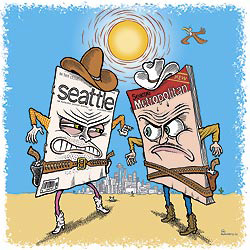At first glance, Subhankar Banerjee’s portrait of a Dall sheep in the Arctic National Wildlife Refuge (ANWR) seems to belong in an issue of National Geographic. Through Banerjee’s lens, the sheep looks majestic, powerful, and proud. Now take another look: Notice the animal’s half-shed coat, its isolation from the herd, and its nearness to the camera. How did the photographer get so close? Why didn’t he wait until after the unsightly shedding phase to take its picture?
Like many of Banerjee’s images, this photo has a directness that belies the not-so-simple story it contains—a story that explains why the Calcutta-born, Bellevue-based photographer won’t be working for National Geographic anytime soon. Accompanied by Robert Thompson, a guide from the Inupiat tribe, Banerjee spent seven months at a time in ANWR over two years to capture the images that make up his new exhibit at the University of Washington’s Burke Museum, Arctic National Wildlife Refuge: Seasons of Life and Land (through Dec. 31; 206-543-5590, www.washington.edu/burkemuseum).At last Tuesday’s press preview, Banerjee talked to me about his approach—literal and figurative—to wildlife photography.
Because his visits to ANWR were open-ended, Banerjee had the luxury of waiting, watching, and getting to know the land. Magazine photographers, on the other hand, operate under severe deadline pressure. “For me, it’s month after month after month,” he said. “So it doesn’t really matter even if I don’t get a specific photo.” His method, relaxed yet wary, is highly effective. Banerjee’s main goal is simply to live among—and come to understand—the animals and people he photographs. He coexisted with the Inupiat tribe for nearly a year before taking out his camera and starting to shoot. “The photo is a secondary thing,” he told me. “I would sit inside a tent anywhere between 36 [and] 48 hours. Then somehow that tent itself, because it’s not moving around, animals get used to it . . . and then your lens is right there.” This kind of patience, along with Banerjee’s unusual knack for composition and vibrant color, is evident in each of the 49 images on display at the Burke. The photographer himself calls the collection “a holistic story of this land”; the museum’s neighboring exhibit, “Native American Wildlife Art of the Arctic,” continues telling this story through Inuit art. Certain pieces, like a stylized musk ox sculpture, are placed within Banerjee’s show, as though to emphasize the native peoples’ interaction with the land. The pairing of the images and native artwork is inspired, since Banerjee considers his involvement with the Inupiat and Gwich’in tribes every bit as important as his photography.
And just as the photos are secondary to Banerjee’s mission, so is any meaning that accrues to a given image. There’s already plenty of artistic significance in the photos themselves: a brooding, seemingly impenetrable fog above the Hulahula River, gorgeous red foliage in the Chandalar River Valley, and the stunning play of light on mountains in Jago River. Banerjee takes great pains not to romanticize the land or its inhabitants; this often means avoiding the painterly, golden light that characterizes ANWR summers. His devotion to realism explains his decision to photograph a half-shed Dall sheep, as well as the starkness of Gwich’in Moose Hunt, which depicts a man crouching over a half-flayed moose carcass. In reference to one of his favorite photos, a God’s-eye view of migrating caribou, Banerjee remarked that they look like ants—tiny and all too easy to wipe out. He said it casually, as though the notion had occurred to him long after the picture was taken.
“The way I look at myself is [as] an artist who’s giving information to [the] public, so that [the] public is empowered to make an informed decision,” Banerjee told me. Take, for example, another gorgeous animal portrait, that of a buff-breasted sandpiper. Only after admiring it do you learn, by reading the accompanying placard, that the species is one of the top five birds on the planet at greatest risk if its habitat is disturbed, and that it lives mostly on ANWR’s coastal plain—the area currently slated for oil drilling. By then it’s the beauty of the image, as much as the fact, that compels you to action. And unlike National Geographic photo essays, which document brief forays into faraway lands a world away from the U.S., Banerjee’s work represents a sustained, impassioned attempt to preserve terrain that’s part of our own country. I think of it as aesthetic activism; whatever you think of it, you can bet it’ll make you think.








